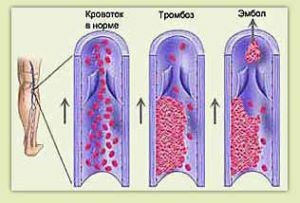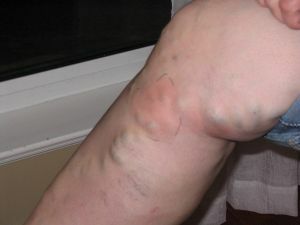 Deep vein thrombosis in the lower limbs is a very common disease. This formation of blood clots in the lower extremities in the lumen of the deep veins. The danger of this disease is that it is often found in absolutely healthy people .
Deep vein thrombosis in the lower limbs is a very common disease. This formation of blood clots in the lower extremities in the lumen of the deep veins. The danger of this disease is that it is often found in absolutely healthy people .
In recent decades, the number of patients with thrombosis has increased, as evidenced by the increase in the number of operations.
Deep vein thrombosis is a disease that causes thrombi in deep veins. The most common form of is thrombosis of the lower extremities. Development is asymptomatic, and the consequences are extremely severe.
content
- Complications due to varicose
- The progress of the disease and its danger
- Symptoms and signs
- disease classification disease
- thrombosis reasons( triad Virchow)
- Precipitating factors and nonspecific causes
- Diagnostic techniques
- complex medical procedures
- Conservative treatment
- Surgery
- rehabilitation after surgery
- Complications of the disease
- Preventive measures
- Video: How to treat thrombosis
Complications due to varicose
In case of varicose veins, phlebitis, thrombosis and thrombophlebitis are considered to be common complications.
Thrombosis is a consequence of the development of thrombophlebitis. Thrombophlebitis is the formation of blood clots in the veins with their subsequent inflammation.
Since thrombosis occurs mainly in the gastrocnemius muscle, the most pronounced signs of it are the sharply appearing swelling of the ankle and the apparent expansion of the calf muscles.
There are often cases when one leg hurts when another person suffers from a thrombosis. According to statistics, thrombosis often affects the left leg.
The course of the disease and its danger
By thrombosis is meant a process that causes blood to coagulate inside the blood vessel, which causes blood flow to be disturbed. With thrombosis of the veins,  cavities of form clots or blood clots of , which impedes normal blood flow.
cavities of form clots or blood clots of , which impedes normal blood flow.
The formation of a blood clot on the vein wall causes inflammation, which leads to the creation of other blood clots.
Severe forms of thrombosis , in which deep veins overlap and the largest collateral branches lead to phlegmation. A sign of phlegmia is the swelling of the entire limb with a violation of microcirculation in the tissues.
The most severe complication of venous thrombosis is venous gangrene, with an amputation of the leg is necessary.
Lower extremity thrombosis can occur without any symptoms. This is the case with a partial overlap with a thrombus of the lumen of the vein and not causing a sudden problem with outflow.
It should be understood that during examination the doctor can only assume a patient has vein thrombosis. A precise diagnosis can be determined only after ultrasound examination of the vessels.
Symptoms and signs of the disease
Symptoms of thrombosis of the veins of the lower extremities can not always be detected easily and immediately. This is due to the restoration through the perforating veins of partially impaired blood outflow.
In general, the symptoms of the disease appear suddenly, but they are not clearly pronounced.
 is characterized by pain in the lower limb, which increases with physical activity .Later there is edema of the diseased limb, a feeling of bursting and heaviness. Skin covers just below the thrombosis site turn pale, often the skin becomes glossy and acquires a cyanotic shade.
is characterized by pain in the lower limb, which increases with physical activity .Later there is edema of the diseased limb, a feeling of bursting and heaviness. Skin covers just below the thrombosis site turn pale, often the skin becomes glossy and acquires a cyanotic shade.
1-2 days after the onset of thrombosis, the enlarged superficial veins beneath the skin clearly appear.
Major signs of thrombosis:
- edema in the area of the injured leg;
- raspiruyuschego character pain, greatly increasing when the position or load changes;
- changes skin color.
Classification of the disease
Thrombosis occur:
- thrombosis of superficial veins of the lower limbs - altered or not altered varicose;
- of the deep veins of the lower extremities.
At the attachment of the thrombus to the wall of the vein:
- With the parietal part of the thrombus splits with the venous wall, but there is a lumen through which the blood enters.
- With the occlusive , the lumen of the vessel is completely closed. Subsequently, the thrombus will grow to the venous wall.
- Mixed type-thrombus can enter both the ascending and descending vascular segments.
- When flotation of thrombosis thrombus can be up to 20cm in length. If you get into a smaller vessel, occlusion may occur.
- Multifocal - in the body in different places clots are formed.
With ileofemoral venous thrombosis, the superficial venous pattern and the smoothness of the inguinal fold are enhanced. Tension of the soft tissues of the lower leg, shiny skin.
The general condition of patients is significantly deteriorating. A distinctive view of ileum-femoral thrombosis is considered to be "blue phlegmase".Pulsation of peripheral arteries can not be determined, and this is fraught with the development of venous gangrene .
Causes of thrombosis( Virchov's triad)
For the formation of a blood clot in a vein, conditions called the triad of Virchow are needed:
- a change in blood composition;
- slowing of blood flow;
- Vascular wall damage.
DVT occurs when the natural process of blood coagulation takes effect not due to damage, but under normal conditions of the vascular wall.
Provoking Factors and Nonspecific Causes
To provoke the development of a disease, the need may not need to change the position of the body for a long time. In this case, the blood flow slows down, the muscle tone decreases, the blood flows to the heart in an inadequate regime, which becomes the cause of thrombosis.
 What are the main types of compression lingerie for varicose veins and how to choose the right model for each specific case read in our article.
What are the main types of compression lingerie for varicose veins and how to choose the right model for each specific case read in our article.
What massage do doctors recommend for varicose veins? What is lpg massage for varicose veins and why do it? Answers to these and many other questions you can find here.
The provoking factors of are:
- age;
- pregnancy and childbirth;
- some big operations;
- reduced activity in road travel, prolonged bed rest, etc.;
- obesity;
- mechanical damage with rupture of blood vessels;
- specific drugs;
- smoking.
Among the non-specific causes contributing to vein thrombosis, there are systemic disorders such as , shock, DIC syndrome, venous stasis due to congenital abnormalities of vessels with accompanying hypotension.
Diagnostic techniques
Diagnosis of various vascular diseases is carried out by invasive and non-invasive methods:
- duplex scanning and Doppler ultrasound - methods aimed at ultrasound examination of vessels. They are

Ultrasound examination of vessels with suspected thrombosis
allows to detect changes in the wall and valves of veins, blood flow velocity;
- phlebography is the most accurate way to detect thrombosis. A contrast agent is injected into the subcutaneous vein of the foot. The presence of thrombi in the form of a defect filling with a contrast agent is revealed on the roentgenogram;
- radionuclide scanning consists in inserting into the vein of the foot a special radioactive preparation accumulating in the thrombus. After scanning, the location of the thrombus is visible;
- impedance plethysmography determines the rate of blood supply to the calf veins and changes in their volume.
Complex of medical procedures
So, how does modern medicine offer treatment for lower limb thrombosis?
In determining the diagnosis, the following thrombosis of the veins of the lower extremities is performed:
- drug therapy using anticoagulant drugs that reduce blood clotting factors;
- introduction of a thrombus soluble substance into a vein;
- surgical removal of thrombus;
- installation of cava filters in the vein.
Conservative treatment of
The main goals of conservative treatment are suppression of subsequent thrombus formation , elimination of inflammation and attachment of thrombus to the walls of vessel , as well as effects on tissue metabolism.
The physician prescribes anticoagulant medications for medical treatment that reduce coagulability of the blood and reduce the risk of re-formation of thrombi. The most common drug is heparin and its derivatives.
Surgery
Only flotation thrombi are subject to .In severe cases of venous thrombosis of the lower extremities that provoke the risk of tissue necrosis, it is appropriate to remove the thrombus by surgery.
This operation is a venous thrombectectomy. Cava filters are implanted in places of dangerous floating thrombi. This method helps people who can not use anticoagulants.
 Methods and techniques of surgical operations in such patients are the subject of discussions.
Methods and techniques of surgical operations in such patients are the subject of discussions.
Some doctors adhere to the of the femoral approach to the trunk veins. Others prefer combined access , i.e.combination of femoral and laparotomic access to the inferior vena cava. The degree of surgical intervention in patients with thrombosis of the lower extremities depends on the degree of defeat of deep veins, the condition of the patient, etc.
Rehabilitation after operation
For several months after the disease, is used indirect anticoagulants under the control of the clotting factor. The patient after the transferred deep vein thrombosis passes into a completely different pathological condition - postthrombophlebitis disease( PTFB) .e
The disease is characterized by developing trophic skin disorders and chronic venous insufficiency, which requires a rehabilitation program.
Rehabilitation program:
- social adaptation and preservation of the standard of living;
- prophylaxis of recurrent disease.
- preventing the development of PTFB and compensating venous outflow.
Complications of the disease
Rarely, occlusive DVT is complicated by venous gangrene.
is also possible following complications:
- painful white reflux due to spasm of arteries located next to the thrombosed vein. It is difficult to distinguish a condition from an acute violation of the arterial blood circulation;
- pain blue phlegmasia : almost all the outflow of blood is blocked due to the occlusion of the iliac and femoral veins, gangrene may occur;
- purulent melting of a thrombus : with the formation of an abscess in acute thrombophlebitis;
- TELA , characterized by a sharp violation of external respiration and blood circulation, and with the overlapping of small branches - symptoms of hemorrhagic infarction of the lung.
Preventive measures
Prevention measures for thrombosis of the veins of the lower of the limbs:
- a healthy lifestyle;
- rejection of tobacco products;
- cholesterol level control;
- compression stockings;
- control of diabetes mellitus;
- reduction of oral contraceptive use;
- rejection of high heels;
- contrast shower.
Preventive procedures:
- performing light physical exercises that improve muscle tone of the affected limbs and blood flow in the veins;
- use of anticoagulants before or after surgery;
- wearing of compression products;
- elastic bandages that do not allow blood flow disorders in the lower limbs.
Pay attention to the signs that gives you your own body. At the first sign of illness should consult a doctor. Stick to the advice of doctors, since vein thrombosis is a very common and dangerous disease.
